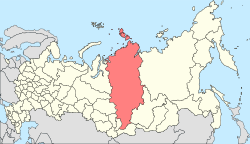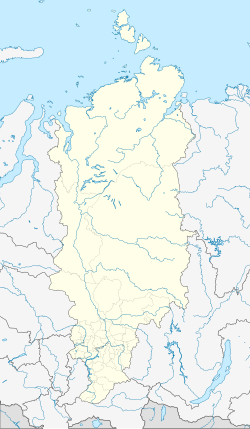Igarka
| Igarka (English) Игарка (Russian) |
|
|---|---|
| - Town - | |
 Location of Krasnoyarsk Krai in Russia |
|
|
|
|
|
|
|
|
|
|
| Administrative status (as of December 2011) | |
| Country | Russia |
| Federal subject | Krasnoyarsk Krai |
| Administrative district | Turukhansky District |
| District town | Igarka |
| Administrative center of | District town of Igarka |
| Municipal status (as of October 2009) | |
| Municipal district | Turukhansky Municipal District |
| Urban settlement | Igarka Urban Settlement |
| Administrative center of | Igarka Urban Settlement |
| Statistics | |
| Population (2010 Census) | 6,183 inhabitants |
| Time zone | KRAT (UTC+07:00) |
| Founded | 1929 |
| Town status since | 1931 |
| on | |
Igarka (Russian: Ига́рка) is a town in Turukhansky District of Krasnoyarsk Krai, Russia, located 163 kilometers (101 mi) north of the Arctic Circle. Population: 6,183 (2010 Census);8,627 (2002 Census);18,820 (1989 Census); 16,000 (1970).
Igarka was founded in 1929 as a sawmill and a timber-exporting port. It was granted town status in 1931. From 1949 to 1953, the Salekhard–Igarka Railway project made an unsuccessful attempt to connect Igarka to the Russian railway network at Salekhard, claiming the lives of thousands of Gulag prisoners. During the deportations of 1948-1951 thousands of civilians were deported to Igarka from newly occupied territories of USSR. In that period some 5000-10000 Lithuanians alone were forcefully moved here from their homeland. About 1000 of them died there from cold and poor conditions in just the winter of 1948-1949.
Population: 6,183 (2010 Census);[3] 8,627 (2002 Census);[5] 18,820 (1989 Census);[6] 16,000 (1970).
Before the collapse of the Soviet Union, the town was predominantly made up of Lithuanians, Germans, Russians, Tatars and Poles. When the Soviet Union fell apart many of these peoples moved back to their respective countries, turning the entire area into an entirely Slavic one populated by Russians, Ukrainians and Belorussians.
...
Wikipedia



